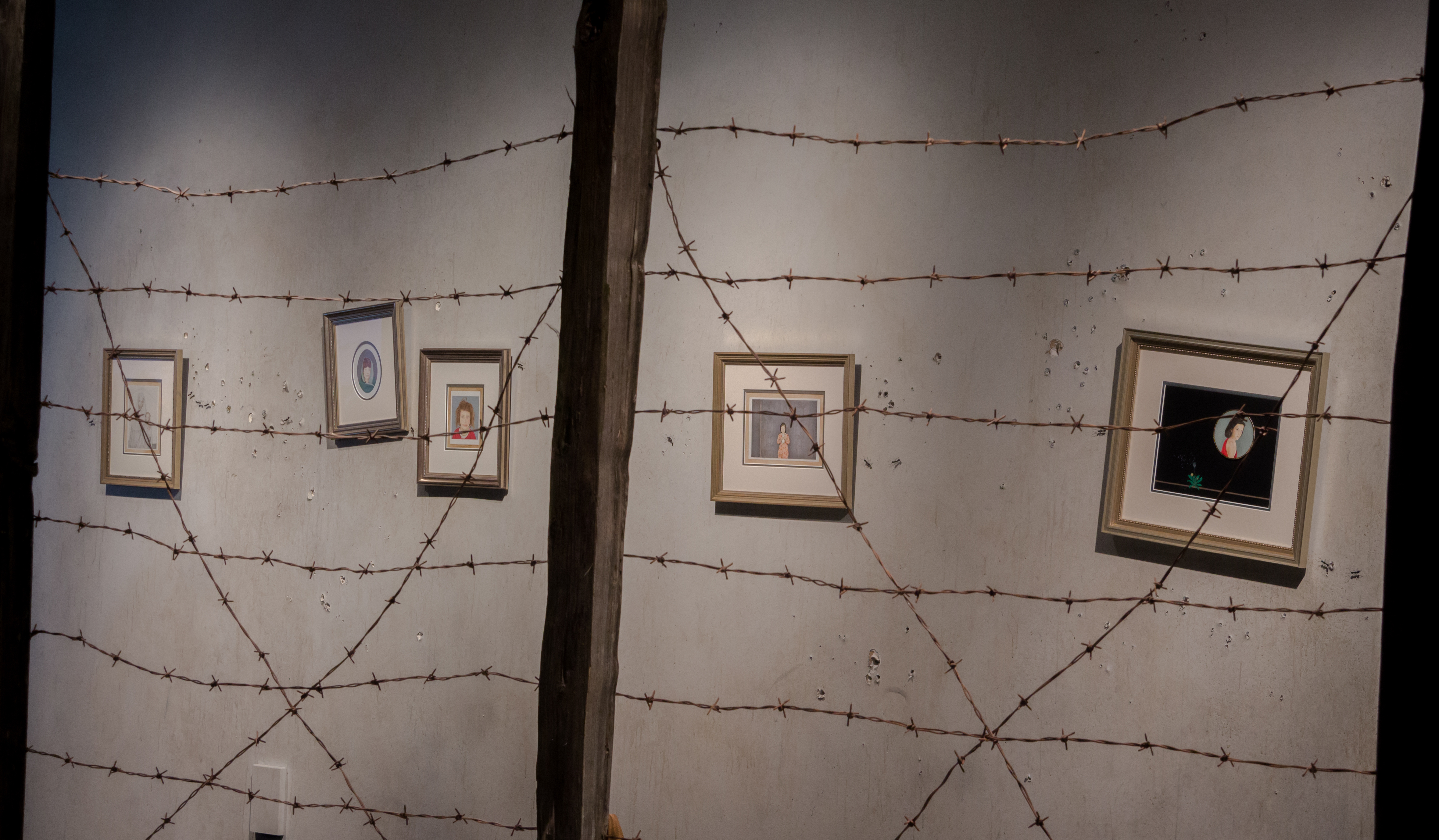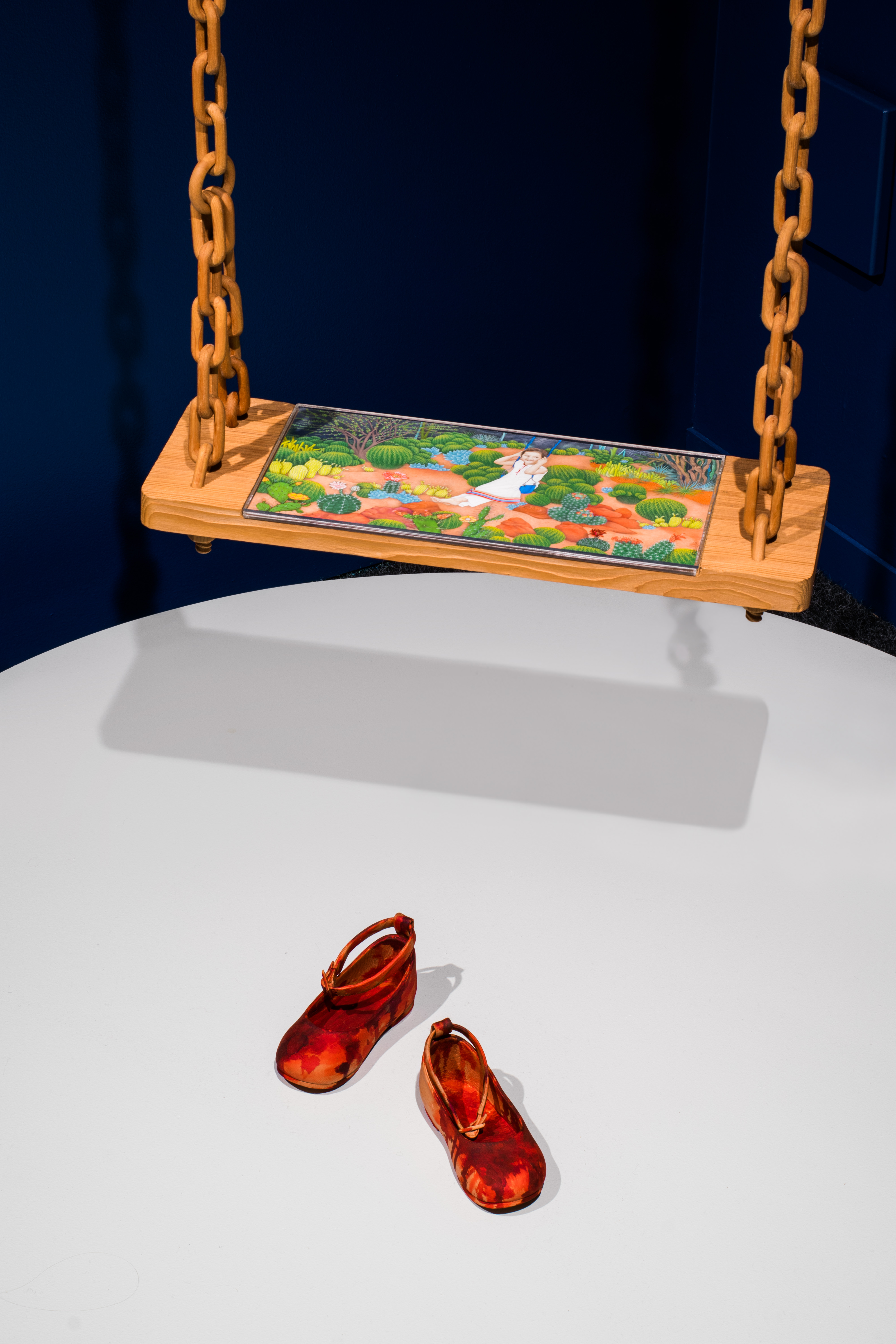Humaira Abid
Meet visual artist based in Lahore and Seattle, Humaira Abid.

Humaira Abid assembling 30 feet long carved barbed wire fence (mahogany wood) before solo show ‘Searching for Home’ at Bellevue Arts Museum, 2017
Tell us a little bit about yourself.
I am a visual artist. I graduated from National College of Arts, Lahore, Pakistan in 2000 and since then have been a full-time artist. I have traveled extensively and have had the opportunity to work with artists and show my work in many countries.
My work is conceptual but also rooted in craft and technique. I believe that a work of art is successful when concept and execution are in balance. I use everyday objects as symbols in my work and present them in unconventional ways to create new meanings. I use my work to talk about social issues and stereotypes, particularly taboos and overlooked issues. I feel as an artist, it’s our responsibility to educate and be a voice for these things. With the added layer of my global perspective as an artist who works in both Pakistan and the United States, I often explore themes from women’s lives that are rarely openly acknowledged in the world of fine art – miscarriage, family, relationships, violence, and freedom.
What is the best and worst thing about living in your city?
I was born in Pakistan and spent most of my life in Lahore. I moved to Seattle 11 years ago. I live and travel between both cities so I will talk about Lahore and Seattle both.
Living in Lahore is challenging and exciting at the same time. It’s the cultural center of Pakistan and has a lot of historical architecture. Food is amazing and people are friendly and social. Summer can be challenging in Lahore with the temperature rising above 50°C (122°F) and since its heavily populated city commute is challenging. But with all its beauty and so much happening – it is always full of excitement, great food, and conversations with friends.
Seattle is lush green, surrounded by lakes, mountains and natural beauty. It is a tech city so many big companies like Boeing, Amazon, Microsoft, T-Mobile, and Expedia have headquarters here. It is also getting very crowded as more and more companies are opening offices here and it is becoming an expensive city to live in. There is so much diversity but not as many good restaurants as the east coast and some other states. And even with so much money, Art and Art Galleries are struggling to survive here but there is support and with new art fairs, focus on art education and public projects – it seems like there may be an improvement in future.
Both the cities are different from each other but both competitive and amazing with all its beauty and challenges. I feel I belong equally to both places and they are home to me.
Both the cities are different from each other but both competitive and amazing with all its beauty and challenges. I feel I belong equally to both places and they are home to me.
Give us 3 words that describe what it’s like to be a creative in your city.
Challenging, Evolving, Inspiring
How did you start your career in art?
I went to art school against the wishes of my family in Pakistan. My parents wanted me to become a doctor and at that time art was not considered a respectable profession but more like a hobby. I wanted to break stereotypes and open doors for the next generation so I took it as a challenge. Not many students were in the fine art department and girls were discouraged to take sculpture as their major being a physically challenging medium. I have always had the impulse to push boundaries – of traditional mediums, materials, and concepts – to create something entirely new.
I chose wood as my primary medium to bring a woman’s voice and point of view to this male-dominated medium. Currently, I often blend South-Asian miniature painting, created painstakingly with brushes as small as a single hair, with carved sculpture and installation to create surreal environments that contain many shades of meaning and symbolism.
I chose wood as my primary medium to bring a woman’s voice and point of view to this male-dominated medium.
Were the people around you supportive of your decision on working as a creative?
Initially, my family and people around me were not supportive but things changed later. I got a scholarship all four years at art school and called back as a faculty member right away. Soon I was established and recognized as an artist. I was able to change the thinking of my family and now my nephew is in art school. Few years after I graduated, my father said in front of the whole family that it was the right decision and he is proud of me – it’s one of the best moments in my life.
What are some goals and ambitions you have for your future work?
I have made a commitment to myself that my new work should be better than my previous work. I am always challenging myself, pushing boundaries and trying new things, technically and conceptually. I want to continue to explore the possibilities, which for many people are impossible. I am passionate about social issues, taboos, and stereotypes. Keeping my focus on wood as the main medium, I am combining it with different mediums and techniques. I like to surprise my audience, bring them closer to work through beauty, details and then make them think about the message behind through layers of symbolism and hidden meanings.
My goal is to keep pushing the boundaries, innovate and create works with a purpose. I feel it’s our responsibility as an artist to educate society and give voice to vulnerable, weak and raise issues. I like to start conversations through my work, which I believe is a step towards realization, resolution, and change.
My goal is to keep pushing the boundaries, innovate and create works with a purpose. I feel it’s our responsibility as an artist to educate society and give voice to vulnerable, weak and raise issues.
If you could collaborate with any person in the world who would it be?
The focus of my current work is refugees and immigrants. I would like to work with women and children at refugee centers, make art with them and give voice to their stories. I feel it’s often the male member of the house who gets to tell the stories and women/children do not get a chance to tell their side.
How would you describe the women around you?
Growing up most women around me were dependant on men financially, emotionally, whenever they had to make a decision, travel, study – almost everything. The strongest person around me was actually my father but he allowed me a voice, he let me make decisions and was like a friend to me. I give a lot of credit to him for helping me achieve my goals and let me be a strong woman who could make her own decisions and pretty much do anything I wanted. I think the lack of examples around me, led me to be one. Growing up in a society where nothing is your own, including your body, mind, decisions, or lifestyle, you have two choices: either accept your fate and live accordingly or stand up and do something. If you decide to stand up you can’t bring change just for yourself. The change has to benefit the whole society in order to be permanent. That’s my intention and art is my tool.
Were there any local female creatives that you looked up to when you were growing up?
I can’t think of an example of female creative that I looked up to when I was growing up. Most creative fields were considered more like a hobby, waste of time and there was no exposure to art and design. Things have changed in Pakistan during the past decade especially in the field of art and there are many examples of strong female creatives who the new generation look up to.
Are there any challenging aspects of being a female in your industry?
Growing up in a patriarchal society, we were discouraged from talking about many topics. I was always interested in women’s issues, stereotypes, and taboo subjects such as puberty, fertility, and sexual relationships. My family was relatively open-minded; girls were treated equally to boys and had all the same opportunities. Maybe that’s why I was allowed a voice and my own point of view, which led to this passion—to give a voice to others who are not able to speak or stand up for themselves.
My father allowed me to question rules or customs if I didn’t agree to them. Much of the time I would ask about social pressures and limitations that are imposed more on women than on men. So it was natural for me to focus on such concepts—what better way to do that than by using art mediums dominated by men?
In my career, I have experienced many challenges in addition to the usual ones that all artists face. Some were more specific to the society in which I was raised, where creating anything three-dimensional (or having a representational character) was considered forbidden according to Islam. Painting nudes or talking about certain topics was discouraged, and then I was a woman working in a patriarchal society and field. Since I had this nature to take on challenges, all of that pressure added to my passion and I was even more driven to keep going. The more I was warned to stop, the stronger my passion grew.
The more I was warned to stop, the stronger my passion grew.
Do you have any advice to young women who are aspiring to work in your field?
If you are passionate about art and it comes out of your heart naturally – it’s your calling. Don’t be afraid to accept challenges, stand out and be the first drop of rain – rest will follow.
Photos courtesy of Humaira Abid, Adeel Ahmed, Emilie Smith, and Matthew Tallorin.
Videos courtesy of Humaira Abid and Seattle Channel.
Website:
Instagram:
Category:
PakistanDate:
April 29, 2019













